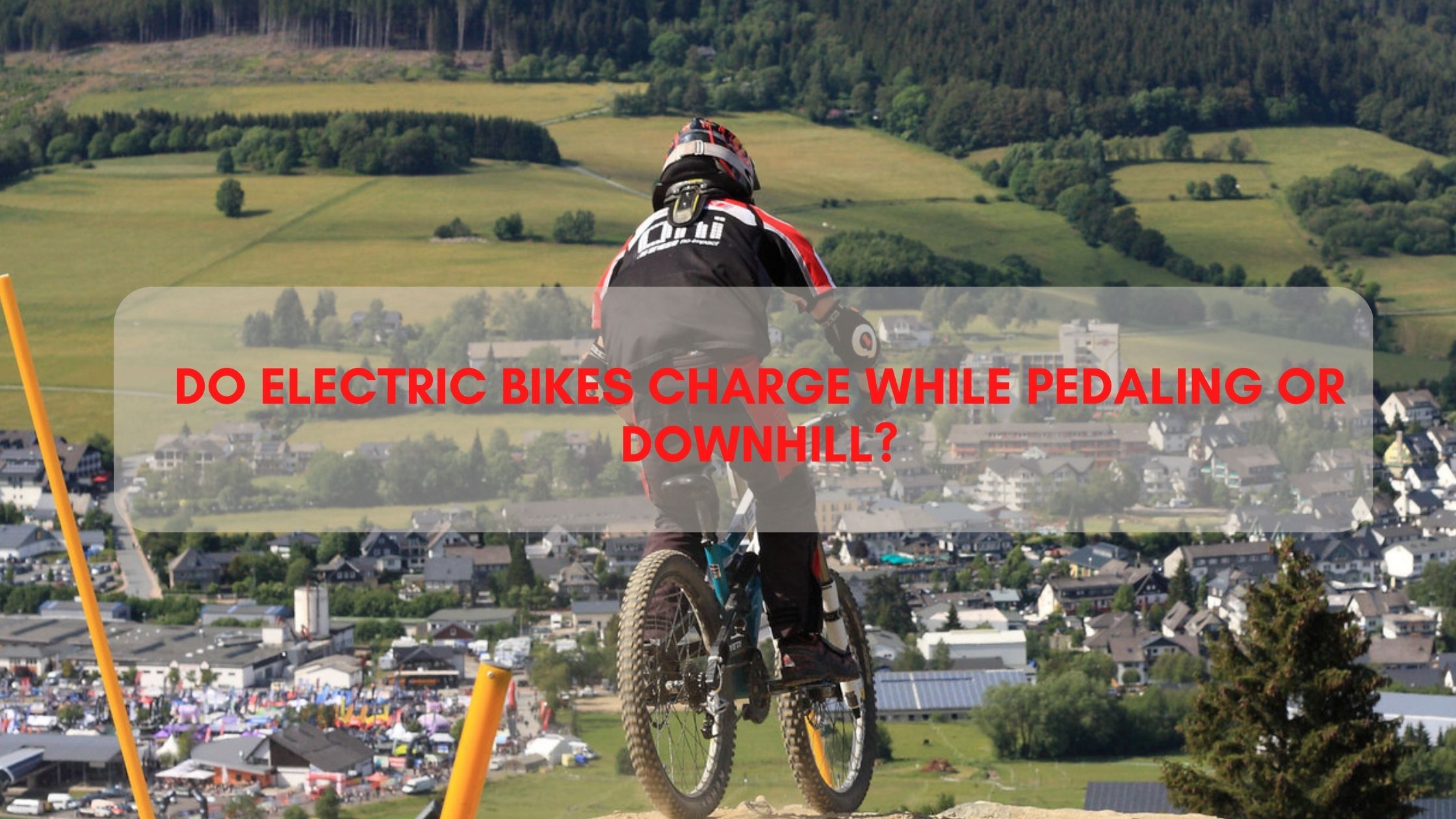Electric bikes are the fastest-growing segment of bikes in the US and, in 2021, occupied the 3rd largest segment of bikes sold, exceeding the sales of road bikes. Several common urban legends exist about electric bikes, including whether they charge while pedaling or rolling downhill.
Some electric bikes do charge the batteries while pedaling or traveling downhill. Unfortunately, these systems are inefficient because they increase the resistance of the pedals (which makes pedaling harder), and only very small amounts of charge are generated for the bike’s battery.
The lightweight electric motors in electric bikes provide enough assistance to take the struggle out of riding a bike without ruining the experience. Unfortunately, the systems used on most electric bikes are not compatible with regenerative charging systems.
Introduction
Although the technology does exist to make an electric bike self-charging, for the reasons discussed in this article, only a small percentage of bikes are equipped with these systems.
Before discussing self-charging systems, it is important to understand where the electric motors are located on an electric bike.
There are two positions in which the bike motors are installed.
- .
- Hub-drive motors.
Mid-Drive Motors
The motor is located between the two pedals on bikes with mid-drive motors.
This means that the assistance provided by the motor is used to turn the pedals.
The advantages of mid-drive motors are as follows.
- Bikes with mid-drive motors generally have a higher range than bikes with hub-drive motors.
- It is easier to remove the rear wheel on bikes with mid-drive motors.
Hub-Drive Motors
On bikes with hub-drive motors, they are installed on the rear wheel axle, providing assistance to the rear wheel.
The advantages of hub-drive motors are as follows.
- The bikes with hub drive motors are generally easier to operate, particularly when a new rider is starting off.
- Bikes with hub-drive motors are the only realistic option for installing a regenerative charging system.
How Do Electric Bikes Normally Charge?
The normal method of charging an electric bike’s battery is to plug the supplied charger into a wall socket.
What Is Regenerative Braking For Electric Bikes?
As discussed in this article, energy cannot be created from nothing, nor can it be destroyed.
A good example of this is the brakes on a bike. Irrespective of whether the bike has a disc, drum, or rubber pad braking system, the energy produced by the brakes has two results.
- It slows the bike down (work.)
- The energy not used is converted to heat.
The principle of regenerative braking systems is that they harness the heat and convert it into electrical energy to recharge the battery.
Most systems work when the rider activates the bike’s brakes. This causes the bike’s motor to turn into a generator. The generator converts the bike’s kinetic energy into electrical current.
Because it draws energy and so friction forces are higher, the motor also acts as a brake.
The braking force is insufficient to slow the bike completely, so the system is used in partnership with the bike’s existing brakes.
The Disadvantages Of Regenerative Braking
With the present state of technology, regenerative braking systems are ineffective.
- The downside of this system is that only direct drive motors can be used, and by necessity, these are much heavier than the traditional motors used on electric bikes.
- The amount of charge regenerated is very small (5% over 30 km is an average.)
- The braking action of the regen system will place forces on the frame, which in the long term could result in fatigue cracking,
- To overcome this, manufacturers must resort to heavier, more engineered frames.
What Is Regenerative Charging For Electric Bikes?
The system works in the exact opposite way in which the engine powers the electric bike.
Bike electric motors are categorized as “DC” motors (direct current.)
If the current to the motor is cut and the motor continues to rotate, the process is reversed, and instead of the motor consuming electricity, it begins to generate electricity.
This is the technology used in regenerative charging systems.
Not All Electric Bikes Recharge While Pedaling
Regenerative charging or “self-charging” systems are available. However, they are only used on a small percentage of electric bikes.
While it is true that all electric motors can potentially become electricity generators, there are several drawbacks.
The law of conservation of energy makes this a difficult solution. This natural law states that energy cannot be created or eliminated.
An energy source other than electricity has to be used for the motor to become a generator. On a bicycle, that energy source is the rider pushing against the pedals, or gravity while the bike is freewheeling down a hill.
As the cyclist makes the pedals turn and the bike move, in theory, electricity can be generated by the motor.
The downside of this is that not only will the cyclist have to produce enough energy to make the bike move (as would normally be the case with an unpowered bike), but they will also have to add more effort to produce the electrical current.
The effect of this is that the bike will have very stiff pedals making it hard to ride.
What About Freewheeling Downhill?
On bikes fitted with a hub motor (on the rear wheel), the rotating wheel can generate electricity as the bike freewheels down a hill.
The energy used to get uphill will always be more than the recharging current added to the system going downhill.
The primary reason is that friction applies to all surfaces. Even going downhill, the friction must be overcome, reducing the amount of current produced.
Advantages And Disadvantages
The advantages and disadvantages of regenerative charging are listed below.
Advantages Of Regenerative Charging
Although the amount of charge regained is small (+-5%), over a 30 km ride, it will result in an additional 1.5 km of range, which may be enough to get the rider back to base.
Disadvantages Of Regenerative Charging
The disadvantages are as follows.
- The systems are very heavy.
- The amount of energy regenerated is small.
- Bikes with regenerative charging systems cost more.
Can You Fully Recharge Your Battery By Pedaling?
The old saying “that nothing is impossible but is it worth it?” holds true when trying to fully recharge an electric bike battery.
The first issue is that while the motor is used to power the electric bike, it cannot simultaneously act as a generator to recharge it.
Assuming that the bike has run out of battery power, if the pedals can be turned, the battery can be charged (assuming the bike has a regenerative recharging system.)
The problem is that the system is inefficient, and the bike will have to be pedaled 20 times further to replace the energy consumed by the motor.
Assuming the bike traveled 30 km on battery power, it must be pedaled 600 km to refill the battery completely.
By this time, the exhausted cyclists will wonder why they did not purchase a conventional bike with no power assistance!
Is There Currently A Self-Charging Electric Bike Available To Buy?
Bikes being sold with regenerative charging systems are listed below.
- ENGWE Upgrade Folding Electric Bicycle for Adults (Amazon Link)
- The HalloMotor Silver Electric Bicycle system can be retrofitted to electric bikes (Amazon Link)
- HalloMotor Electric Bicycle system can be retrofitted to electric bikes (Amazon Link)
Could E-Bikes Charge Themselves In The Future?
Regenerative systems may be designed that are more efficient.
The following technological advances will be required.
- The energy lost to friction will have to be minimized.
- Ideally, the bikes will be used on very smooth, level roads.
- Lighter direct electric motors will have to be developed.
- More efficient energy recapture systems are needed.
More efficient, lighter, and longer-lasting batteries are required.
Final Thought
As wonderful as the idea is, no regenerative charging systems available for the latest generation of electric bikes are efficient or worthwhile.
Hopefully, new technologies will be developed, which will make this a viable solution in the future.



